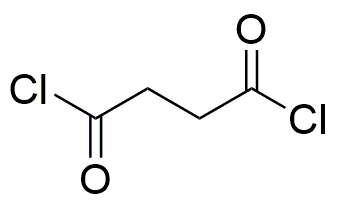Succinyl chloride is widely utilized in research focused on:
- Synthesis of Peptides: It serves as a key reagent in the synthesis of peptides and proteins, facilitating the formation of amide bonds, which are essential for building these biomolecules.
- Pharmaceutical Development: This compound is important in the pharmaceutical industry for creating active pharmaceutical ingredients (APIs), particularly in the development of drugs that require acylation reactions.
- Polymer Chemistry: Succinyl chloride is used in the production of various polymers, enhancing properties such as solubility and thermal stability, which are crucial for applications in coatings and adhesives.
- Modification of Surfaces: It is employed to modify surfaces of materials, improving adhesion and compatibility in applications like biomedical devices and sensors.
- Research in Organic Chemistry: Researchers utilize it to explore reaction mechanisms and develop new synthetic pathways, making it a valuable tool in academic and industrial laboratories.
General Information
Properties
Safety and Regulations
Applications
Succinyl chloride is widely utilized in research focused on:
- Synthesis of Peptides: It serves as a key reagent in the synthesis of peptides and proteins, facilitating the formation of amide bonds, which are essential for building these biomolecules.
- Pharmaceutical Development: This compound is important in the pharmaceutical industry for creating active pharmaceutical ingredients (APIs), particularly in the development of drugs that require acylation reactions.
- Polymer Chemistry: Succinyl chloride is used in the production of various polymers, enhancing properties such as solubility and thermal stability, which are crucial for applications in coatings and adhesives.
- Modification of Surfaces: It is employed to modify surfaces of materials, improving adhesion and compatibility in applications like biomedical devices and sensors.
- Research in Organic Chemistry: Researchers utilize it to explore reaction mechanisms and develop new synthetic pathways, making it a valuable tool in academic and industrial laboratories.
Documents
Safety Data Sheets (SDS)
The SDS provides comprehensive safety information on handling, storage, and disposal of the product.
Product Specification (PS)
The PS provides a comprehensive breakdown of the product’s properties, including chemical composition, physical state, purity, and storage requirements. It also details acceptable quality ranges and the product's intended applications.
Certificates of Analysis (COA)
Search for Certificates of Analysis (COA) by entering the products Lot Number. Lot and Batch Numbers can be found on a product’s label following the words ‘Lot’ or ‘Batch’.
*Catalog Number
*Lot Number
Certificates Of Origin (COO)
This COO confirms the country where the product was manufactured, and also details the materials and components used in it and whether it is derived from natural, synthetic, or other specific sources. This certificate may be required for customs, trade, and regulatory compliance.
*Catalog Number
*Lot Number
Safety Data Sheets (SDS)
The SDS provides comprehensive safety information on handling, storage, and disposal of the product.
DownloadProduct Specification (PS)
The PS provides a comprehensive breakdown of the product’s properties, including chemical composition, physical state, purity, and storage requirements. It also details acceptable quality ranges and the product's intended applications.
DownloadCertificates of Analysis (COA)
Search for Certificates of Analysis (COA) by entering the products Lot Number. Lot and Batch Numbers can be found on a product’s label following the words ‘Lot’ or ‘Batch’.
*Catalog Number
*Lot Number
Certificates Of Origin (COO)
This COO confirms the country where the product was manufactured, and also details the materials and components used in it and whether it is derived from natural, synthetic, or other specific sources. This certificate may be required for customs, trade, and regulatory compliance.


